Pemetrexed
Editor-In-Chief: C. Michael Gibson, M.S., M.D. [1]; Associate Editor(s)-in-Chief: Alonso Alvarado, M.D. [2]
Disclaimer
WikiDoc MAKES NO GUARANTEE OF VALIDITY. WikiDoc is not a professional health care provider, nor is it a suitable replacement for a licensed healthcare provider. WikiDoc is intended to be an educational tool, not a tool for any form of healthcare delivery. The educational content on WikiDoc drug pages is based upon the FDA package insert, National Library of Medicine content and practice guidelines / consensus statements. WikiDoc does not promote the administration of any medication or device that is not consistent with its labeling. Please read our full disclaimer here.
Overview
Pemetrexed is a antineoplastic agent that is FDA approved for the treatment of non-squamous non-small cell lung cancer, mesothelioma. Common adverse reactions include itching, peeling of skin, constipation, diarrhea, loss of appetite, nausea, pharyngitis, stomatitis, vomiting, anemia, leukopenia, neutropenia, thrombocytopenia, fatigue.
Adult Indications and Dosage
FDA-Labeled Indications and Dosage (Adult)
Combination Use with Cisplatin for Nonsquamous Non-Small Cell Lung Cancer or Malignant Pleural Mesothelioma
The recommended dose of pemetrexed is 500 mg/m2 administered as an intravenous infusion over 10 minutes on Day 1 of each 21-day cycle. The recommended dose of cisplatin is 75 mg/m2 infused over 2 hours beginning approximately 30 minutes after the end of pemetrexed administration. See cisplatin package insert for more information.
Single-Agent Use as Maintenance Following First-Line Therapy, or as a Second-Line Therapy
The recommended dose of pemetrexed is 500 mg/m2 administered as an intravenous infusion over 10 minutes on Day 1 of each 21-day cycle.
Premedication Regimen and Concurrent Medications
Vitamin Supplementation
- Instruct patients to initiate folic acid 400 mcg to 1000 mcg orally once daily beginning 7 days before the first dose of pemetrexed. Continue folic acid during the full course of therapy and for 21 days after the last dose of pemetrexed.
- Administer vitamin B12 1 mg intramuscularly 1 week prior to the first dose of pemetrexed and every 3 cycles thereafter. Subsequent vitamin B12 injections may be given the same day as treatment with pemetrexed.
Corticosteroids
Administer dexamethasone 4 mg by mouth twice daily the day before, the day of, and the day after pemetrexed administration.
Laboratory Monitoring and Dose Reduction/Discontinuation Recommendations
Monitoring
Complete blood cell counts, including platelet counts, should be performed on all patients receiving pemetrexed. Patients should be monitored for nadir and recovery, which were tested in the clinical study before each dose and on days 8 and 15 of each cycle. Patients should not begin a new cycle of treatment unless the ANC is ≥1500 cells/mm3, the platelet count is ≥100,000 cells/mm3, and creatinine clearance is ≥45 mL/min. Periodic chemistry tests should be performed to evaluate renal and hepatic function.
Dose Reduction Recommendations
Dose adjustments at the start of a subsequent cycle should be based on nadir hematologic counts or maximum nonhematologic toxicity from the preceding cycle of therapy. Treatment may be delayed to allow sufficient time for recovery. Upon recovery, patients should be retreated using the guidelines in Tables 1-3, which are suitable for using pemetrexed as a single-agent or in combination with cisplatin.

If patients develop nonhematologic toxicities (excluding neurotoxicity) ≥Grade 3, treatment should be withheld until resolution to less than or equal to the patient's pre-therapy value. Treatment should be resumed according to guidelines in Table 2.

In the event of neurotoxicity, the recommended dose adjustments for pemetrexed and cisplatin are described in Table 3. Patients should discontinue therapy if Grade 3 or 4 neurotoxicity is experienced.

Discontinuation Recommendation
ALIMTA therapy should be discontinued if a patient experiences any hematologic or nonhematologic Grade 3 or 4 toxicity after 2 dose reductions or immediately if Grade 3 or 4 neurotoxicity is observed.
Renally Impaired Patients
In clinical studies, patients with creatinine clearance ≥45 mL/min required no dose adjustments other than those recommended for all patients. Insufficient numbers of patients with creatinine clearance below 45 mL/min have been treated to make dosage recommendations for this group of patients. Therefore, pemetrexed should not be administered to patients whose creatinine clearance is <45 mL/min using the standard Cockcroft and Gault formula (below) or GFR measured by Tc99m-DTPA serum clearance method:

Caution should be exercised when administering pemetrexed concurrently with NSAIDs to patients whose creatinine clearance is <80 mL/min [see Drug Interactions (7.1)].
Preparation and Administration Precautions
As with other potentially toxic anticancer agents, care should be exercised in the handling and preparation of infusion solutions of pemetrexed. The use of gloves is recommended. If a solution of pemetrexed contacts the skin, wash the skin immediately and thoroughly with soap and water. If pemetrexed contacts the mucous membranes, flush thoroughly with water. Several published guidelines for handling and disposal of anticancer agents are available.
pemetrexed is not a vesicant. There is no specific antidote for extravasation of pemetrexed. To date, there have been few reported cases of pemetrexed extravasation, which were not assessed as serious by the investigator. Pemetrexed extravasation should be managed with local standard practice for extravasation as with other non-vesicants.
Preparation for Intravenous Infusion Administration
- Use aseptic technique during the reconstitution and further dilution of pemetrexed for intravenous infusion administration.
- Calculate the dose of pemetrexed and determine the number of vials needed. Vials contain either 100 mg or 500 mg of pemetrexed. The vials contain an excess of pemetrexed to facilitate delivery of label amount.
- Reconstitute each 100-mg vial with 4.2 ml of 0.9% Sodium Chloride Injection (preservative free). Reconstitute each 500-mg vial with 20 mL of 0.9% Sodium Chloride Injection (preservative free). Reconstitution of either size vial gives a solution containing 25 mg/mL pemetrexed. Gently swirl each vial until the powder is completely dissolved. The resulting solution is clear and ranges in color from colorless to yellow or green-yellow without adversely affecting product quality. The pH of the reconstituted pemetrexed solution is between 6.6 and 7.8. FURTHER DILUTION IS REQUIRED.
- Parenteral drug products should be inspected visually for particulate matter and discoloration prior to administration, whenever solution and container permit. If particulate matter is observed, do not administer.
- An appropriate quantity of the reconstituted pemetrexed solution must be further diluted into a solution of 0.9% Sodium Chloride Injection (preservative free), so that the total volume of solution is 100 ml. pemetrexed is administered as an intravenous infusion over 10 minutes.
- Chemical and physical stability of reconstituted and infusion solutions of pemetrexed were demonstrated for up to 24 hours following initial reconstitution, when stored refrigerated. When prepared as directed, reconstitution and infusion solutions of pemetrexed contain no antimicrobial preservatives. Discard any unused portion.
Reconstitution and further dilution prior to intravenous infusion is only recommended with 0.9% Sodium Chloride Injection (preservative free). pemetrexed is physically incompatible with diluents containing calcium, including Lactated Ringer's Injection, USP and Ringer's Injection, USP and therefore these should not be used. Coadministration of pemetrexed with other drugs and diluents has not been studied, and therefore is not recommended. Pemetrexed is compatible with standard polyvinyl chloride (PVC) administration sets and intravenous solution bags.
Off-Label Use and Dosage (Adult)
Guideline-Supported Use
There is limited information regarding Off-Label Guideline-Supported Use of Pemetrexed in adult patients.
Non–Guideline-Supported Use
Condition 1
- Dosing Information
- (Dosage)
Condition 2
- Dosing Information
- (Dosage)
Condition 3
- Dosing Information
- (Dosage)
Pediatric Indications and Dosage
FDA-Labeled Indications and Dosage (Pediatric)
There is limited information regarding Pemetrexed FDA-Labeled Indications and Dosage (Pediatric) in the drug label.
Off-Label Use and Dosage (Pediatric)
Guideline-Supported Use
There is limited information regarding Off-Label Guideline-Supported Use of Pemetrexed in pediatric patients.
Non–Guideline-Supported Use
There is limited information regarding Off-Label Non–Guideline-Supported Use of Pemetrexed in pediatric patients.
Contraindications
Pemetrexed is contraindicated in patients who have a history of severe hypersensitivity reaction to pemetrexed.
Warnings
Requirement for Premedication and Concomitant Medication to Reduce Toxicity
Vitamin Supplementation
Prior to treatment with pemetrxed, initiate supplementation with oral folic acid and intramuscular vitamin B12 to reduce the severity of hematologic and gastrointestinal toxicity of pemetrxed. Do not substitute oral vitamin B12 for intramuscular vitamin B12. In clinical studies, the incidence of the following Grade 3-4 toxicities were higher in patients with mesothelioma who were never supplemented as compared to patients who were fully supplemented with folic acid and vitamin B12 prior to and throughout pemetrxed treatment: neutropenia [38% versus 23%], thrombocytopenia [9% versus 5%], febrile neutropenia [9% versus 0.6%], and infection with neutropenia [6% versus. 0].
Corticosteroids
Administer dexamethasone the day before, the day of, and the day after pemetrxed administration.
Bone Marrow Suppression
Pemetrxed can suppress bone marrow function, as manifested by neutropenia, thrombocytopenia, and anemia (or pancytopenia); myelosuppression is usually the dose-limiting toxicity. Dose reductions for subsequent cycles are based on nadir ANC, platelet count, and maximum nonhematologic toxicity seen in the previous cycle.
Decreased Renal Function
Pemetrxed is primarily eliminated unchanged by renal excretion. No dosage adjustment is needed in patients with creatinine clearance ≥45 mL/min. Insufficient numbers of patients have been studied with creatinine clearance <45 mL/min to give a dose recommendation. Therefore, pemetrxed should not be administered to patients whose creatinine clearance is < 45 mL/min.
One patient with severe renal impairment (creatinine clearance 19 mL/min) who did not receive folic acid and vitamin B12 died of drug-related toxicity following administration of pemetrxed alone.
Use with Non-Steroidal Anti-Inflammatory Drugs (NSAIDs) with Mild to Moderate Renal Insufficiency
Caution should be used when administering NSAIDs concurrently with pemetrxed to patients with mild to moderate renal insufficiency (creatinine clearance from 45 to 79 mL/min).
Required Laboratory Monitoring
Obtain a complete blood count and renal function tests at the beginning of each cycle and as needed. Do not initiate a cycle of treatment unless the ANC is ≥1500 cells/mm3, the platelet count is ≥100,000 cells/mm3, and creatinine clearance is ≥45 mL/min.
Pregnancy Category D
Based on its mechanism of action, pemetrxed can cause fetal harm when administered to a pregnant woman. Pemetrexed administered intraperitoneally to mice during organogenesis was embryotoxic, fetotoxic and teratogenic in mice at greater than 1/833rd the recommended human dose. If pemetrxed is used during pregnancy, or if the patient becomes pregnant while taking this drug, the patient should be apprised of the potential hazard to the fetus. Women of childbearing potential should be advised to avoid becoming pregnant. Women should be advised to use effective contraceptive measures to prevent pregnancy during treatment with pemetrxed.
Adverse Reactions
Clinical Trials Experience
Because clinical trials are conducted under widely varying conditions, adverse reactions rates cannot be directly compared to rates in other clinical trials and may not reflect the rates observed in clinical practice.
In clinical trials, the most common adverse reactions (incidence ≥20%) during therapy with pemetrexed as a single-agent were fatigue, nausea, and anorexia. Additional common adverse reactions (incidence ≥20%) during therapy with pemetrexed when used in combination with cisplatin included vomiting, neutropenia, leukopenia, anemia, stomatitis/pharyngitis, thrombocytopenia, and constipation.
Non-Small Cell Lung Cancer (NSCLC) – Pemetrexed in Combination with Cisplatin
- Table 4 provides the frequency and severity of adverse reactions that have been reported in > 5% of 839 patients with NSCLC who were randomized to study and received pemetrexed plus cisplatin and 830 patients with NSCLC who were randomized to study and received gemcitabine plus cisplatin. All patients received study therapy as initial treatment for locally advanced or metastatic NSCLC and patients in both treatment groups were fully supplemented with folic acid and vitamin B12.
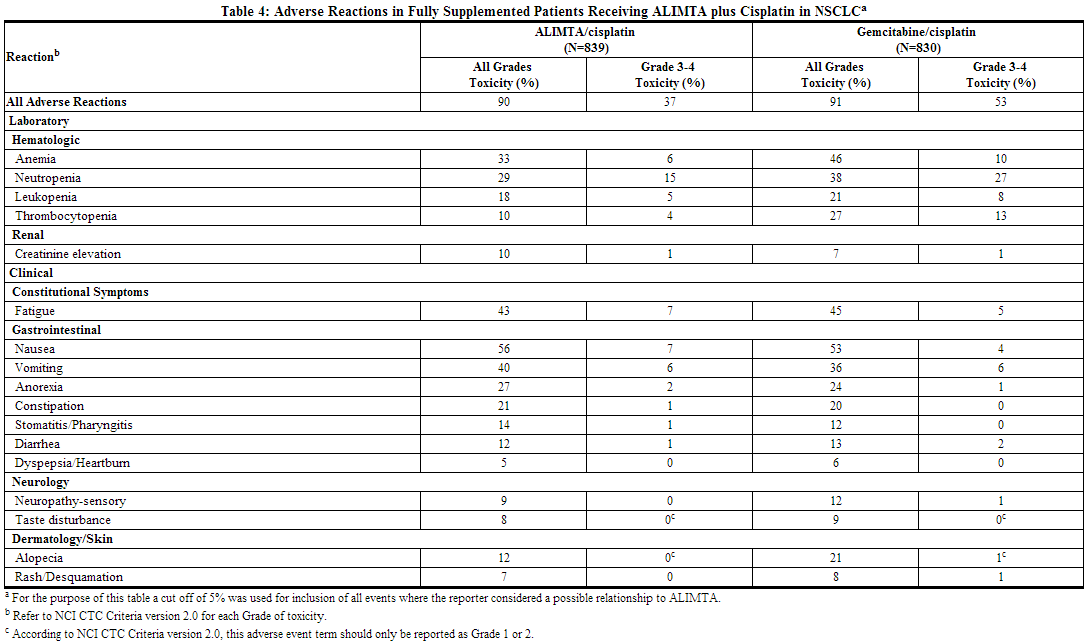
- No clinically relevant differences in adverse reactions were seen in patients based on histology.
- In addition to the lower incidence of hematologic toxicity on the pemetrexed and cisplatin arm, use of transfusions (RBC and platelet) and hematopoietic growth factors was lower in the pemetrexed and cisplatin arm compared to the gemcitabine and cisplatin arm.
The following additional adverse reactions were observed in patients with non-small cell lung cancer randomly assigned to receive pemetrexed plus cisplatin
Incidence 1% to 5%
- Body as a Whole: febrile neutropenia, infection, pyrexia
- General Disorders: dehydration
- Metabolism and Nutrition: increased AST, increased ALT
- Renal: creatinine clearance decrease, renal failure
- Special Senses: conjunctivitis
Incidence Less than 1%
- Cardiovascular: arrhythmia
- General Disorders: chest pain
- Metabolism and Nutrition: increased GGT
- Neurology: motor neuropathy
Non-Small Cell Lung Cancer (NSCLC) – Maintenance
Pemetrexed Maintenance Following Non-Pemetrexed Containing, Platinum-Based Induction Therapy
- Table 5 provides the frequency and severity of adverse reactions reported in >5% of the 438 patients with NSCLC who received pemetrexed maintenance and the 218 patients with NSCLC who received placebo following a platinum-based induction therapy.
- All patients received study therapy immediately following 4 cycles of platinum-based treatment for locally advanced or metastatic NSCLC. Patients in both study arms were fully supplemented with folic acid and vitamin B12.
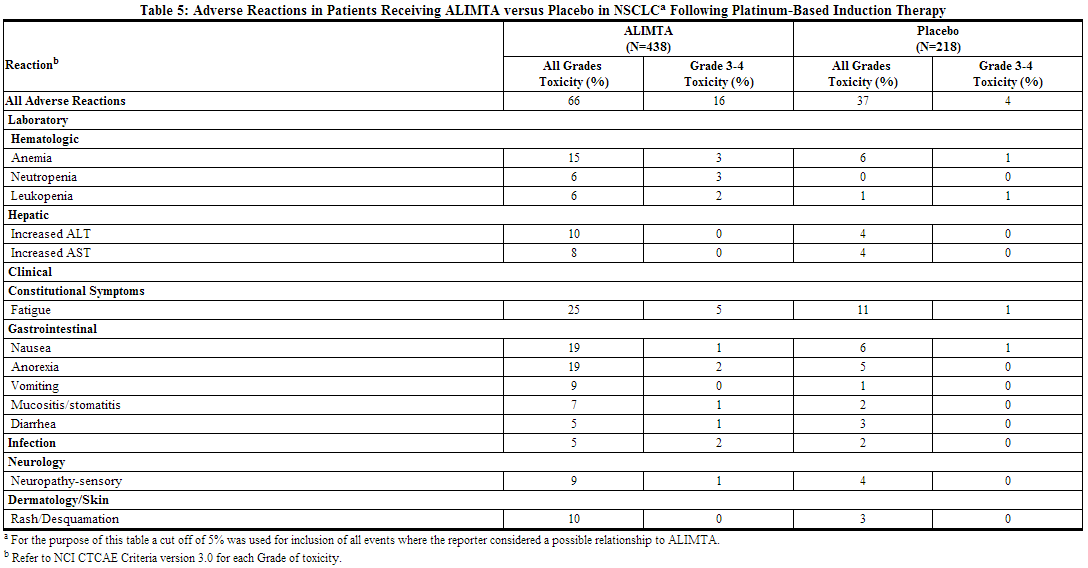
- No clinically relevant differences in Grade 3/4 adverse reactions were seen in patients based on age, gender, ethnic origin, or histology except a higher incidence of Grade 3/4 fatigue for Caucasian patients compared to non-Caucasian patients (6.5% versus 0.6%).
- Safety was assessed by exposure for patients who received at least one dose of pemetrexed (N=438). The incidence of adverse reactions was evaluated for patients who received ≤6 cycles of pemetrexed, and compared to patients who received >6 cycles of pemetrexed. Increases in adverse reactions (all grades) were observed with longer exposure; however no clinically relevant differences in Grade 3/4 adverse reactions were seen.
- Consistent with the higher incidence of anemia (all grades) on the pemetrexed arm, use of transfusions (mainly RBC) and erythropoiesis stimulating agents (ESAs; erythropoietin and darbepoetin) were higher in the pemetrexed arm compared to the placebo arm (transfusions 9.5% versus 3.2%, ESAs 5.9% versus 1.8%).
The following additional adverse reactions were observed in patients with non-small cell lung cancer who received pemetrexed
Incidence 1% to 5%
- Dermatology/Skin: alopecia, pruritis/itching
- Gastrointestinal: constipation
- General Disorders: edema, fever (in the absence of neutropenia)
- Hematologic: thrombocytopenia
- Renal: decreased creatinine clearance, increased creatinine, decreased glomerular filtration rate
- Special Senses: ocular surface disease (including conjunctivitis), increased lacrimation
Incidence Less than 1%
- Cardiovascular: supraventricular arrhythmia
- Dermatology/Skin: erythema multiforme
- General Disorders: febrile neutropenia, allergic reaction/hypersensitivity
- Neurology: motor neuropathy
- Renal: renal failure
Continuation of Pemetrexed as Maintenance Following Pemetrexed Plus Platinum Induction Therapy
- Table 6 provides the frequency and severity of adverse reactions reported in >5% of the 500 patients with non-squamous NSCLC who received at least one cycle of pemetrexed maintenance (n=333) or placebo (n=167) on the continuation maintenance trial.
- The median of maintenance cycles administered to patients receiving one or more doses of maintenance therapy was 4 on both the pemetrexed and placebo arms. Dose reductions for adverse events occurred in 3.3% of patients in the pemetrexed arm and 0.6% in the placebo arm. Dose delays for adverse events occurred in 22% of patients in the pemetrexed arm and 16% in the placebo arm. Patients in both study arms were supplemented with folic acid and vitamin B12.
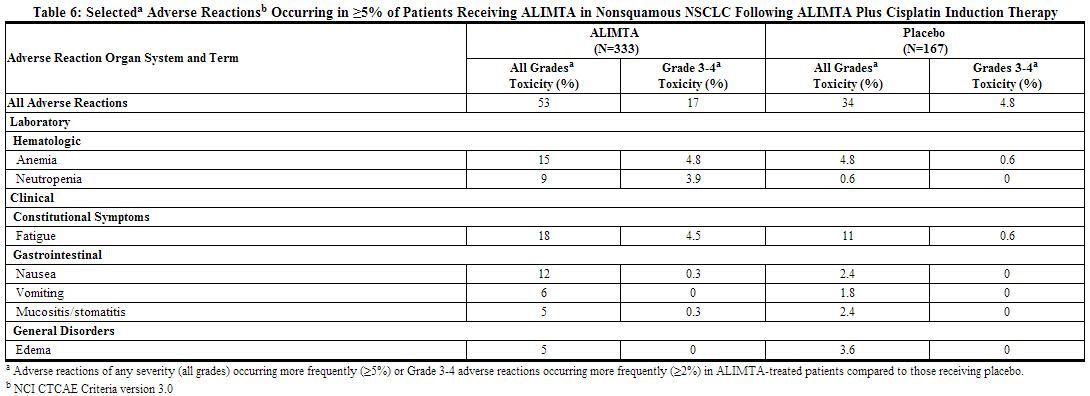
- Administration of RBC (13% versus 4.8%) and platelet (1.5% versus 0.6%) transfusions, erythropoiesis stimulating agents (12% versus 7%), and granulocyte colony stimulating factors (6% versus 0) were higher in the pemetrexed arm compared to the placebo arm.
The following additional Grade 3 or 4 adverse reactions were observed more frequently in the pemetrexed arm
Incidence 1% to 5%
- Blood/Bone Marrow: thrombocytopenia
- General Disorders: febrile neutropenia
Incidence Less than 1%
- Cardiovascular: ventricular tachycardia, syncope
- General Disorders: pain
- Gastrointestinal: gastrointestinal obstruction
- Neurologic: depression
- Renal: renal failure
- Vascular: pulmonary embolism
Non-Small Cell Lung Cancer (NSCLC) – After Prior Chemotherapy
- Table 7 provides the frequency and severity of adverse reactions that have been reported in >5% of 265 patients randomly assigned to receive single-agent pemetrexed with folic acid and vitamin B12 supplementation and 276 patients randomly assigned to receive single-agent docetaxel. All patients were diagnosed with locally advanced or metastatic NSCLC and received prior chemotherapy.
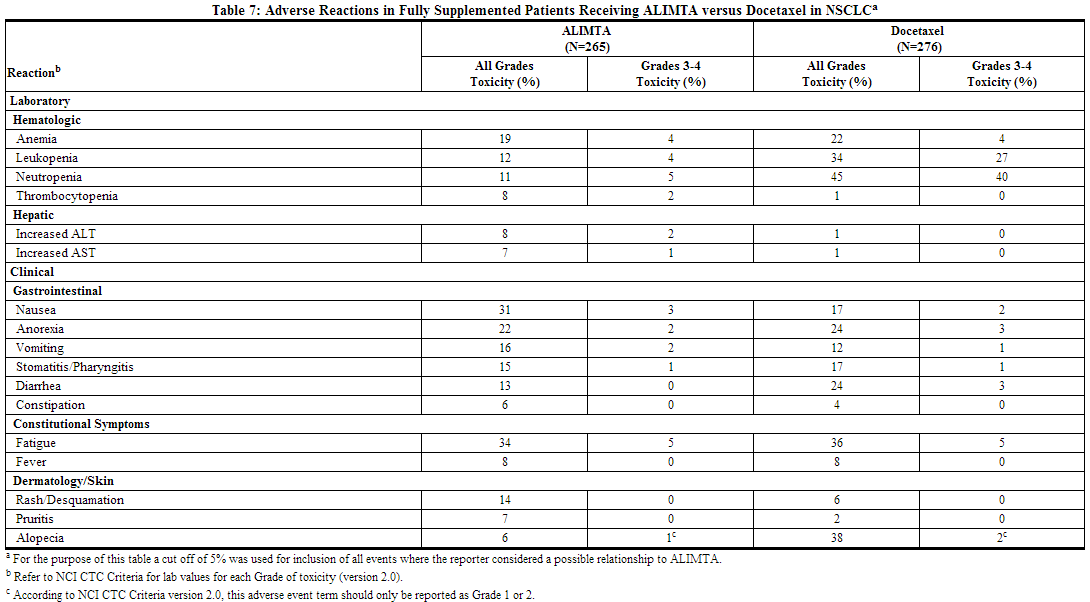
- No clinically relevant differences in adverse reactions were seen in patients based on histology.
- Clinically relevant adverse reactions occurring in <5% of patients that received pemetrexed treatment but >5% of patients that received docetaxel include CTC Grade 3/4 febrile neutropenia (1.9% pemetrexed, 12.7% docetaxel).
The following additional adverse reactions were observed in patients with non-small cell lung cancer randomly assigned to receive pemetrexed
Incidence 1% to 5%
- Body as a Whole: abdominal pain, allergic reaction/hypersensitivity, febrile neutropenia, infection
- Dermatology/Skin: erythema multiforme
- Neurology: motor neuropathy, sensory neuropathy
- Renal: increased creatinine
Incidence Less than 1%
- Cardiovascular: supraventricular arrhythmias
Malignant Pleural Mesothelioma (MPM)
- Table 8 provides the frequency and severity of adverse reactions that have been reported in >5% of 168 patients with mesothelioma who were randomly assigned to receive cisplatin and pemetrexed and 163 patients with mesothelioma randomly assigned to receive single-agent cisplatin. In both treatment arms, these chemonaive patients were fully supplemented with folic acid and vitamin B12.
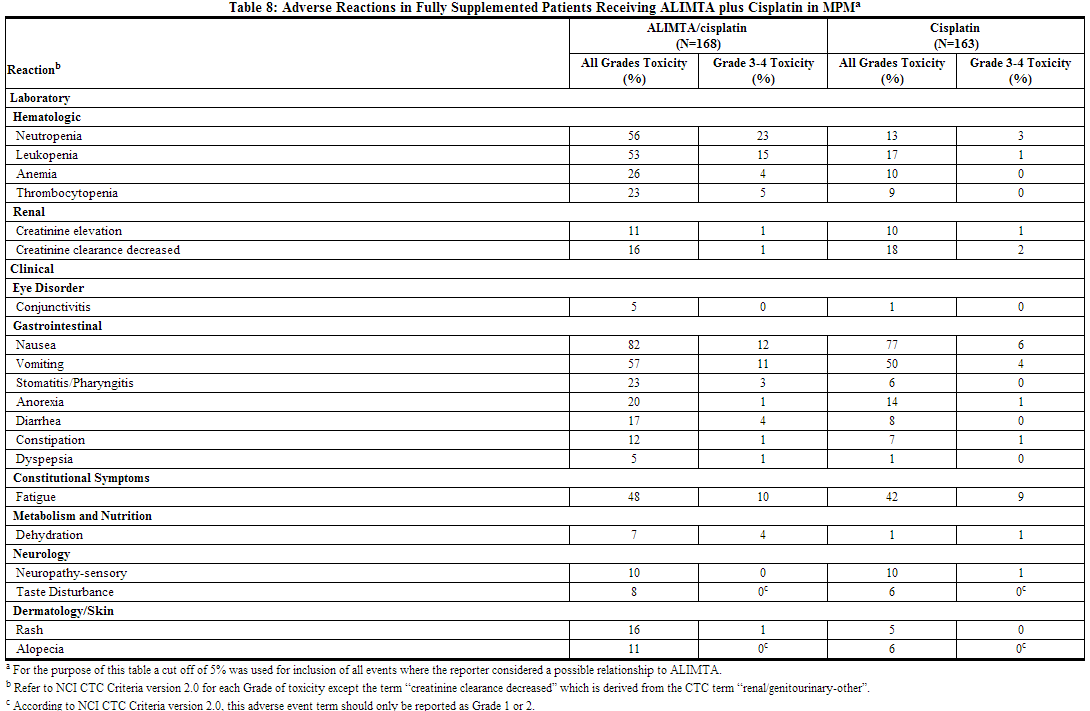
The following additional adverse reactions were observed in patients with malignant pleural mesothelioma randomly assigned to receive pemetrexed plus cisplatin. Incidence 1% to 5% Body as a Whole: febrile neutropenia, infection, pyrexia Dermatology/Skin: urticaria General Disorders: chest pain Metabolism and Nutrition: increased AST, increased ALT, increased GGT Renal: renal failure
Incidence Less than 1% Cardiovascular: arrhythmia Neurology: motor neuropathy
Effects of Vitamin Supplementations on Toxicity
- Table 9 compares the incidence (percentage of patients) of CTC Grade 3/4 toxicities in patients who received vitamin supplementation with daily folic acid and vitamin B12 from the time of enrollment in the study (fully supplemented) with the incidence in patients who never received vitamin supplementation (never supplemented) during the study in the pemetrexed plus cisplatin arm.

- The following adverse events were greater in the fully supplemented group compared to the never supplemented group: hypertension (11%, 3%), chest pain (8%, 6%), and thrombosis/embolism (6%, 3%).
- No relevant effect for pemetrexed safety due to gender or race was identified, except an increased incidence of rash in men (24%) compared to women (16%).
Additional Experience Across Clinical Trials
- Sepsis, which in some cases was fatal, occurred in approximately 1% of patients.
- Esophagitis occurred in less than 1% of patients.
Postmarketing Experience
The following adverse reactions have been identified during post-approval use of pemetrexed. Because these reactions are reported voluntarily from a population of uncertain size, it is not always possible to reliably estimate their frequency or establish a causal relationship to drug exposure. These reactions occurred with pemetrexed when used as a single-agent and in combination therapies:
- Blood and Lymphatic System: immune-mediated hemolytic anemia
- Gastrointestinal: colitis, pancreatitis
- General Disorders and Administration Site Conditions: edema
- Injury, poisoning, and procedural complications: Radiation recall has been reported in patients who have previously received radiotherapy.
- Respiratory: interstitial pneumonitis
- Skin: Bullous conditions, including Stevens-Johnson syndrome and toxic epidermal necrolysis. Some cases were fatal.
Drug Interactions
- Drug 1
- Drug 2
- Drug 3
- Drug 4
- Drug 5
Drug 1
(Description)
Drug 2
(Description)
Drug 3
(Description)
Drug 4
(Description)
Drug 5
(Description)
Use in Specific Populations
Pregnancy
Pregnancy Category (FDA):
(Description)
Pregnancy Category (AUS):
(Description)
Labor and Delivery
(Description)
Nursing Mothers
(Description)
Pediatric Use
(Description)
Geriatic Use
(Description)
Gender
(Description)
Race
(Description)
Renal Impairment
(Description)
Hepatic Impairment
(Description)
Females of Reproductive Potential and Males
(Description)
Immunocompromised Patients
(Description)
Others
(Description)
Administration and Monitoring
Administration
(Oral/Intravenous/etc)
Monitoring
Condition 1
(Description regarding monitoring, from Warnings section)
Condition 2
(Description regarding monitoring, from Warnings section)
Condition 3
(Description regarding monitoring, from Warnings section)
IV Compatibility
Solution
Compatible
- Solution 1
- Solution 2
- Solution 3
Not Tested
- Solution 1
- Solution 2
- Solution 3
Variable
- Solution 1
- Solution 2
- Solution 3
Incompatible
- Solution 1
- Solution 2
- Solution 3
Y-Site
Compatible
- Solution 1
- Solution 2
- Solution 3
Not Tested
- Solution 1
- Solution 2
- Solution 3
Variable
- Solution 1
- Solution 2
- Solution 3
Incompatible
- Solution 1
- Solution 2
- Solution 3
Admixture
Compatible
- Solution 1
- Solution 2
- Solution 3
Not Tested
- Solution 1
- Solution 2
- Solution 3
Variable
- Solution 1
- Solution 2
- Solution 3
Incompatible
- Solution 1
- Solution 2
- Solution 3
Syringe
Compatible
- Solution 1
- Solution 2
- Solution 3
Not Tested
- Solution 1
- Solution 2
- Solution 3
Variable
- Solution 1
- Solution 2
- Solution 3
Incompatible
- Solution 1
- Solution 2
- Solution 3
TPN/TNA
Compatible
- Solution 1
- Solution 2
- Solution 3
Not Tested
- Solution 1
- Solution 2
- Solution 3
Variable
- Solution 1
- Solution 2
- Solution 3
Incompatible
- Solution 1
- Solution 2
- Solution 3
Overdosage
Acute Overdose
Signs and Symptoms
(Description)
Management
(Description)
Chronic Overdose
Signs and Symptoms
(Description)
Management
(Description)
Pharmacology
| File:Pemetrexed.svg | |
Pemetrexed
| |
| Systematic (IUPAC) name | |
| 2-[4-[2-(4-amino-2-oxo-3,5,7-triazabicyclo[4.3.0] nona-3,8,10-trien-9-yl)ethyl] benzoyl] aminopentanedioic acid | |
| Identifiers | |
| CAS number | |
| ATC code | L01 |
| PubChem | |
| DrugBank | |
| Chemical data | |
| Formula | Template:OrganicBox atomTemplate:OrganicBox atomTemplate:OrganicBoxTemplate:OrganicBoxTemplate:OrganicBoxTemplate:OrganicBoxTemplate:OrganicBoxTemplate:OrganicBoxTemplate:OrganicBoxTemplate:OrganicBoxTemplate:OrganicBoxTemplate:OrganicBoxTemplate:OrganicBoxTemplate:OrganicBox atomTemplate:OrganicBoxTemplate:OrganicBox atomTemplate:OrganicBoxTemplate:OrganicBoxTemplate:OrganicBoxTemplate:OrganicBoxTemplate:OrganicBoxTemplate:OrganicBoxTemplate:OrganicBox |
| Mol. mass | 427.411 g/mol |
| Pharmacokinetic data | |
| Bioavailability | NA |
| Protein binding | 81% |
| Metabolism | Negligible |
| Half life | 3.5 hours |
| Excretion | Renal |
| Therapeutic considerations | |
| Licence data |
, |
| Pregnancy cat. |
D(US) |
| Legal status |
POM(UK) [[Prescription drug|Template:Unicode-only]](US) |
| Routes | IV |
Mechanism of Action
(Description)
Structure
(Description with picture)
Pharmacodynamics
(Description)
Pharmacokinetics
(Description)
Nonclinical Toxicology
(Description)
Clinical Studies
Condition 1
(Description)
Condition 2
(Description)
Condition 3
(Description)
How Supplied
(Description)
Storage
There is limited information regarding Pemetrexed Storage in the drug label.
Images
Drug Images
{{#ask: Page Name::Pemetrexed |?Pill Name |?Drug Name |?Pill Ingred |?Pill Imprint |?Pill Dosage |?Pill Color |?Pill Shape |?Pill Size (mm) |?Pill Scoring |?NDC |?Drug Author |format=template |template=DrugPageImages |mainlabel=- |sort=Pill Name }}
Package and Label Display Panel
{{#ask: Label Page::Pemetrexed |?Label Name |format=template |template=DrugLabelImages |mainlabel=- |sort=Label Page }}
Patient Counseling Information
(Patient Counseling Information)
Precautions with Alcohol
Alcohol-Pemetrexed interaction has not been established. Talk to your doctor about the effects of taking alcohol with this medication.
Brand Names
There is limited information regarding Pemetrexed Brand Names in the drug label.
Look-Alike Drug Names
- (Paired Confused Name 1a) — (Paired Confused Name 1b)
- (Paired Confused Name 2a) — (Paired Confused Name 2b)
- (Paired Confused Name 3a) — (Paired Confused Name 3b)
Drug Shortage Status
Drug Shortage
Price
References
The contents of this FDA label are provided by the National Library of Medicine.